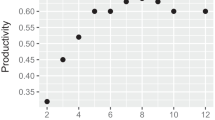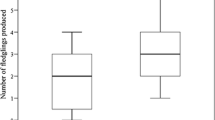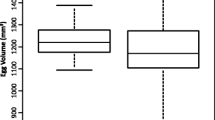Abstract
Prebreeding Seychelles warblers (Acrocephalus sechellensis) frequently act as helpers on their natal territory, aiding in territory defence, predator mobbing, nestbuilding, incubation (only females) and feeding dependent young of their parents. In some cases helpers could attain breeding status (e.g. by joint-nesting) in their natal group and become co-breeders. Comparisons of group size and reproductive success on a given quality territory suggest that the presence of alloparents (helpers and cobreeders) significantly affects the reproductive success of their parents. The influence of alloparents on reproductive success was examined by removing alloparents from breeding units and comparing the success of natural-sized and artificially reduced groups. Removal experiments, controlled for territory quality, group size and breeder age, showed that the presence of one alloparent significantly improved the reproductive success of its parents. Analysis strongly suggests that this was entirely due to helping behaviour (i.e. providing care to offspring of their parents), thereby improving the helper's inclusive fitness benefits from staying at home. However, these experiments showed also that the presence of two or more alloparents in medium-quality territories significantly decreased reproductive success, compared with groups with one alloparent. Several lines of evidence suggest that this may have been due to the joint-nesting and reproductive competition that could occur in breeding groups, or simply to resource depression when a large number of previous offspring remained on their natal territory.
Similar content being viewed by others
References
Bathe GM, Bathe HV (1982) Territory size and habitat requirements of the Seychelles brush warbler Acrocephalus (Bebrornis) sechellensis. Internal Report, International Council for Bird Preservation, Cambridge
Brooke M de L, Houston DC (1983) The biology and biomass of the skinks Mabuya wrightii and Mabuya sechellensis on Cousin Island, Seychelles. J Zool London 200:779–795
Brown JL (1987) Helping and communal breeding in birds: ecology and evolution. Princeton University Press, Princeton
Brown JL, Brown ER, Brown SD, Dow DD (1982) Helpers: effects of experimental removal on reproductive success. Science 215:421–422
Crook JH (1960) The present status of certain rare landbirds of the Seychelles Islands. Unnumbered Seychelles Government Bulletin
Diamond AW (1980) Seasonality, population structure and breeding ecology of the Seychelles brush warbler Acrocephalus sechellensis. Proc Pan-African Ornithol Congr 4:253–266
Emlen ST (1984) Cooperative breeding in birds and mammals. In: Krebs JR, Davies NB (eds) Behavioural ecology: an evolutionary approach, 1st edn. Sinauer, Sunderland, pp 305–339
Emlen ST (1991) Evolution of cooperative breeding in birds and mammals. In: Krebs JR, Davies NB (eds) Behavioural ecology: an evolutionary approach, 3rd edn. Blackwell, Oxford, pp 301–337
Koenig WD, Mumme RL (1990) Levels of analysis and the functional significance of helping behaviour. In: Bekoff M, Jamieson D (eds) Interpretation and explanation in the study of animal behavior. Vol II. Explanation, evolution, and adaptation. West view, Boulder, pp 268–303
Komdeur J (1991) Cooperative breeding in the Seychelles warbler. PhD disseration, University of Cambridge, UK
Komdeur J (1992) Importance of habitat saturation and territory quality for evolution of cooperative breeding in the Seychelles warbler. Nature 358:493–495
Komdeur J (in press) Conserving the Seychelles warbler Acrocephalus sechellensis by translocation from Cousin Island to the islands of Aride and Cousine. Biol Conserv
Komdeur J, Bullock ID, Rands MRW (1991) Conserving the Seychelles warbler by translocation: a transfer from Cousin Island to Aride Island. Bird Conserv Int 1:179–188
Leonard ML, Horn AG, Eden SF (1989) Does juvenile helping enhance breeder reproductive success? A removal experiment on moorhens. Behav Ecol Sociobiol 25:357–361
Mumme RL (1991) Helping behaviour in the Florida scrub jay: nonaptation, exaptation, or adaptation? Acta Congr Int Ornithol 20:1317–1324
Mumme RL (1992) Do helpers increase reproductive success? An experimental analysis in the Florida scrub jay. Behav Ecol Sociobiol 31:319–328
Owen HV (1986) Management plan of Cousin Island, Seychelles (unpublished report). International Council for Bird Preservation, Cambridge
Smith JNM (1990) Summary. In: Stacey PB, Koenig WD (eds) Cooperative breeding in birds: long-term studies of ecology and behavior. Cambridge University Press, Cambridge, pp 593–611
Author information
Authors and Affiliations
Rights and permissions
About this article
Cite this article
Komdeur, J. Experimental evidence for helping and hindering by previous offspring in the cooperative-breeding Seychelles warbler Acrocephalus sechellensis . Behav Ecol Sociobiol 34, 175–186 (1994). https://doi.org/10.1007/BF00167742
Received:
Accepted:
Issue Date:
DOI: https://doi.org/10.1007/BF00167742




